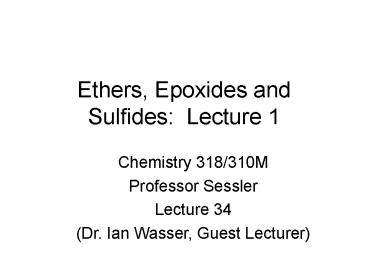Chemistry 318310M - PowerPoint PPT Presentation
1 / 21
Title:
Chemistry 318310M
Description:
Friday (11/19/04): Review Exam III Answer Key. Monday (11/22/04): New ... group ether is added with acid, stabile under the basic alkylating conditons and ... – PowerPoint PPT presentation
Number of Views:56
Avg rating:3.0/5.0
Title: Chemistry 318310M
1
Ethers, Epoxides and Sulfides Lecture 1
Chemistry 318/310M Professor Sessler Lecture
34 (Dr. Ian Wasser, Guest Lecturer)
2
Today New Material, Chapter 11 (A Short
Lecture)
Friday (11/19/04) Review Exam III Answer Key
Monday (11/22/04) New Material, finish Ch. 11
Wednesday (11/24/04) No Class, Happy
Thanksgiving
Monday (11/29/04) Professor Sessler Returns
3
Ethers Structure and Nomenclature
An ether is a functional grop with two carbons
bound to an oxygen. For example dimethyl ether,
CH3OCH3.
4
Nomenclature By IUPAC rules ethers are named by
selecting the longest carbon chain as the parent
alkane and naming the -OR group attached to as
the alkoxy substituent. Common names are
derived by naming the alkyl groups bonded to the
oxygen in alphabetical order and adding the word
ether.
5
Physical Properties of Ethers
Ethers are polar molecules where the oxygen has a
partial negative charge, and the carbons have
partial positive charges. This leads to dipole
interactions in the liquid, although these are
weak. Ethers cannot act as hydrogen bond donors
and are less soluble in water than alcohols.
However they can accept hydrogen bonds which
makes them more soluble in water than
hydrocarbons.
6
Due to their weak dipole dipole intercations
ethers have lower boiling points than the
alcohols of corresponding molecular weight. They
have boiling points much closer to hydrocarbons
of similar molecular weight.
Compare with alcohols
7
Preparation of Ethers
The most common ether preparation is the
Williamson ether synthesis. It is a general
method for ether synthesis involving the SN2
reaction between an alkyl halide and an alkoxide
anion. In planning a Williamson ether synthesis
it is crucial to select conditions and reactants
that maximize nucleophilic substitution and
minimizes b-elimination.
SN2
8
b-elimination
Yields of the Williamson ether synthesis are the
highest with primary and methyl halides.
Secondary halides give low yields and tertiary
halides fail to react, both due to competing E2
b-elimination.
9
Ether Synthesis Problems
Propose a Synthesis for Each Ether Product
10
Ether Synthesis Problems
11
Acid-Catalyzed Dehydration of Alcohols
Some of the commercially available ethers are
synthesized on industrial scale using high
temperatures and strong acids. The alcohol
group is activated by the acid and by an SN2
attack of a hydroxyl group it is displaced to
give an ether. Dehydration is a competitive
process, but it requires higher heat. Therefore
dehydration can be reduced by controlling
experimental conditions.
mech
12
Acid-Catalyzed Addition of Alcohols to Alkenes
Under the right conditions alcohols can be added
into alkenes to give ethers. Limits are alkenes
that can form stable carbocations and primary and
methyl alcohols. Example t-butyl methyl ether
mech
13
Sample Problem
Propose a mechanism for the following transformati
on
14
(No Transcript)
15
Reactions of Ethers
Ethers are resistant to chemical reaction, like
hydrocarbons. They are stable to potassium
dichromate or permanganate. Very strong bases
are unreactive towards ethers, and except for 3o
alkyl ethers they are not reactive toward weak
acids at moderate temperatures. For these
reasons, among others, ethers make good solvents.
However strong acids, such as HX, can cleave
ethers. Ether cleavage requires a strong acid and
a good nucleophile. Therefore, concentrated HI
and HBr are the acids of choice for this
reaction.
16
mech
17
Oxidation of Ethers - Formation of Hydroperoxides
One of the hazards of working with low-molecular
weight ethers (other than their high
flammability) is their reactivity with
oxygen. Anhydrous ethers react with O2 at the C-H
adjacent to the ether oxygen to give explosive
hydroperoxides.
Hydroperoxidation proceeds by a radical chain
mechanism. If the C-H next to the oxygen is
secondary, rates of peroxidation are increased
due to the stability of the 2o radical
intermediate.
18
Hydroperoxides are highly explosive. They can be
detected by a simple starch test, where KI is
oxidized to I2 by the hydroperoxide which in turn
reacts with the starch to give a deep blue
color. Hyrdoperoxides are destroyed by treating
with a reducing agent, such as Fe(II) sulfate in
dilute acid. Precipitated peroxides of
diisopropyl ether are best left to the BOMB
SQUAD!
19
Ethers as Protecting Groups
In many cases where two functional groups exist
in a molecule it is necessary to protect one in
order to do chemistry on the other. One such
example is with an alcohol and an alkyne.
- Under the conditions needed to form the acetylide
ion, the alcohol is deprotonated, and thus made
more nucleophilic. - It is necessary to protect the alcohol.
Protecting groups must - Easily added to sensitive group
- Resistant to the reagents used to transform the
unprotected group - Easily removed to regenerate the original group
20
All these criteria are met for the alkylation of
the acetylide ion when the alcohol is protected
as a tert-butyl ether.
The protecting group ether is added with acid,
stabile under the basic alkylating conditons and
removed with weak acid to regenerate the
alcohol. Another type of ether protecting group
is the silyl ether, which is removed by acid or
(F-) fluoride ion.
21
Since there was an Exam Last Night,
Enjoy Your Afternoon.. (Class is over early!)































